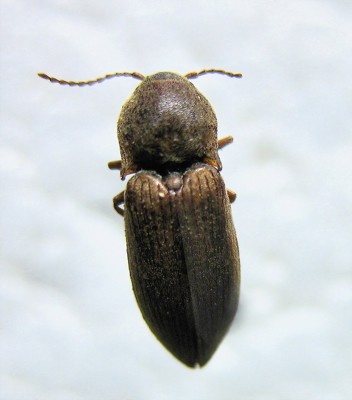Pests
Agriotes obscurus L. . Dusky Wireworm Beetle
Systematic position.
Class Insecta, order Coleoptera, family Elateridae, subfamily Agriotinae, tribe Agriotini, genus Agriotes.Biological group.
Polyphagous pests.Morphology and biology.
Beetle is dark-brown and dull, 7-10 mm long and 2 mm wide. Body of the beetle is fairly convex; elytra are covered with yellow-gray hairs. Pronotum is wider than long. Eggs are white, nearly globe-shaped, to 0.5 mm in diameter. Larva is dark-yellow, with metallic glitter, 25 mm long and 2 mm wide. The apex of last segment of larval body is sharp-pointed. Pupa is white, 9-12 mm long. The larvae are hard, nearly cylindrical, and shining as those in all the species of Elateridae. They are named as "wireworms", because they look like a wire fragment. A. obscurus has 4-6-year generation development. Beetles fly from May to August in forest zone and from April to the end of June in steppe zone. They reproduce after additional feeding by parenchyma of cereal leaves. Females lay eggs on radical parts of plants or into soil on a depth to 5 cm, placing them by groups of 3-18 eggs in each one. The total female fecundity is 75-230 eggs. All the preimaginal stages develop in soil. The larvae develop during 4-5 years in forest zone and 3 years in steppe zone. During this period, they molt 8-11 times, wintering to a depth of 20-50 cm. Adult larvae pupate in July-August. Young imagoes emerge in July-August and stay wintering in soil to a depth of 10-25 cm.Distribution.
A. obscurus is a widespread Eastern-Palearctic species. Its area spreads all over the forest, steppe-forest, and steppe zones of Eurasia from Atlantic to Pacific Ocean, including the Northern Caucasus, Northern Kazakhstan, and Northern Mongolia. The beetle is most numerous and harmful in Europe in the zone of predominance of coniferous forests and podzolic soils of the northern type, and also in forest-steppe districts of Siberia. The pest has been introduced to Northern America.Ecology.
A.obscurus is a polyphagous insect being initially connected with cereal plants. Imagoes and larvae are somewhat hygrophilous. The beetles remain in shaded places, being more active in twilight. Their pairing occurs on soil surface. Females select oviposition places according with optimal microclimatic conditions, such as the temperature 17-25°C and air humidity 80-90% within herbage. These conditions are usually formed on fields with grain cereals and perennial grasses, and also on fields settled by couch-grass (Agropyrum repens) at a high level. Eggs develop during 20-30 days, and pupae develop during 14-20 days under the soil temperature 18-23°C. The thermal limits for feeding and development of larvae are 10 to 35°C. The larvae move actively in soil, seeking food or places with optimal thermal (18-21°C) and soil humidity (50-60%) conditions. Natural enemies of all elaterid beetles are ground-beetles of the genera Carabus, Calosoma, Harpalus, Amara (Coleoptera, Carabidae), more than 200 species of birds, and also moles, toads, and lizards. They eat many beetles and larvae on fields after spring and autumn plowings.Economic significance.
The larvae (wireworms) are only harmful in A.obscurus and other phytophagous beetles of the family Elateridae. They eat seeds, seedlings, and underground parts of various agricultural crops and weeds. The wireworms are more harmful for the grain cereals (for maize especially), sunflower, potato, solanaceous and cruciferous vegetables, carrot, beet, turnip, being less harmful for oats, pea, clover, alfalfa, flax, and mustard. Their harmfulness consists in causing shoot thinning, depression of damaged plants, and deterioration of commercial quality of potato tubers, beet and carrot edible roots. The economical threshold of wireworm numbers in major crops (maize, potato, sugar beet) is 3 to 15 larvae per 1 sq. m. The A.obscurus real population density may reach 180 larvae per 1 sq. m. on some fields, but usually not more than 30-40 larvae per 1 sq. m.. On average. The wireworm harmfulness decreases in the middle of summer because they migrate to the deeper and more humid soil layers (>30 cm) during hot, dry weather. Preventive and protective measures are the extermination of weeds, especially the couch-grass; deep subsurface tillage of fallow fields; cultivation and interrow treatment of soil on tilled crop plantations in spring and in early summer; early after-harvesting autumn plowing of soil; extermination of crop plant residues; application of organic fertilizers in high doses; application of soil insecticides in spring before sowing, if the wireworm population density is higher than economical threshold for the crop.Reference citations:
Anon. 2005. Economical Threshold Levels of main pests of agricultural crops. / Plant Protection and Quarantine. 10: 36-38; 11: 40-43. (In Russian)Bobinskaya S.G., Grigorjeva T.G., Persin S.A. 1965. The wireworms and control measures against them. Leningrad: Kolos. 223 pp. (In Russian)
Chenkin A.F., Grivanov K.P., eds. 1974. Reference Book for plant protection. Moscow: Rosselkhozizdat. 400 pp. (In Russian)
Cherepanov A.I. 1965. Wireworms of Western Siberia. Мoscow: Nauka, 190 pp. (In Russian)
Dolin V.G. 1964. Elaterid beetle larvae (wireworms) of the European part of the USSR. Kiev: Urozhai. 206 pp. (In Russian)
Gurjeva E.L. 1972. Review of palearctic species of Elaterid beetles of the genus Agriotes Esch. (Coleoptera, Elateridae). / Entomologicheskoe obozrenie 51 (4): 859-877. (In Russian)
Ermolenko V.M. 1971. Atlas of insect pests of field crops. Kiev: Urozhai. 176 pp. (In Ukrainian)
Kryzhanovsky O.L., ed. 1974. Beetles. Insects and mites . the pests of agricultural crops. Vol. II. Leningrad: Nauka. 336 pp. (In Russian)
Pavlov I.F. 1987. Protection of field crops from pests. Moscow: Rosselkhozizdat. 256 pp. (In Russian)
Sagitov A.O., Ismukhambetov Zh.D., ed. 2004. Reference Book for plant protection. Almaty: ROND. 320 pp. (In Russian)


